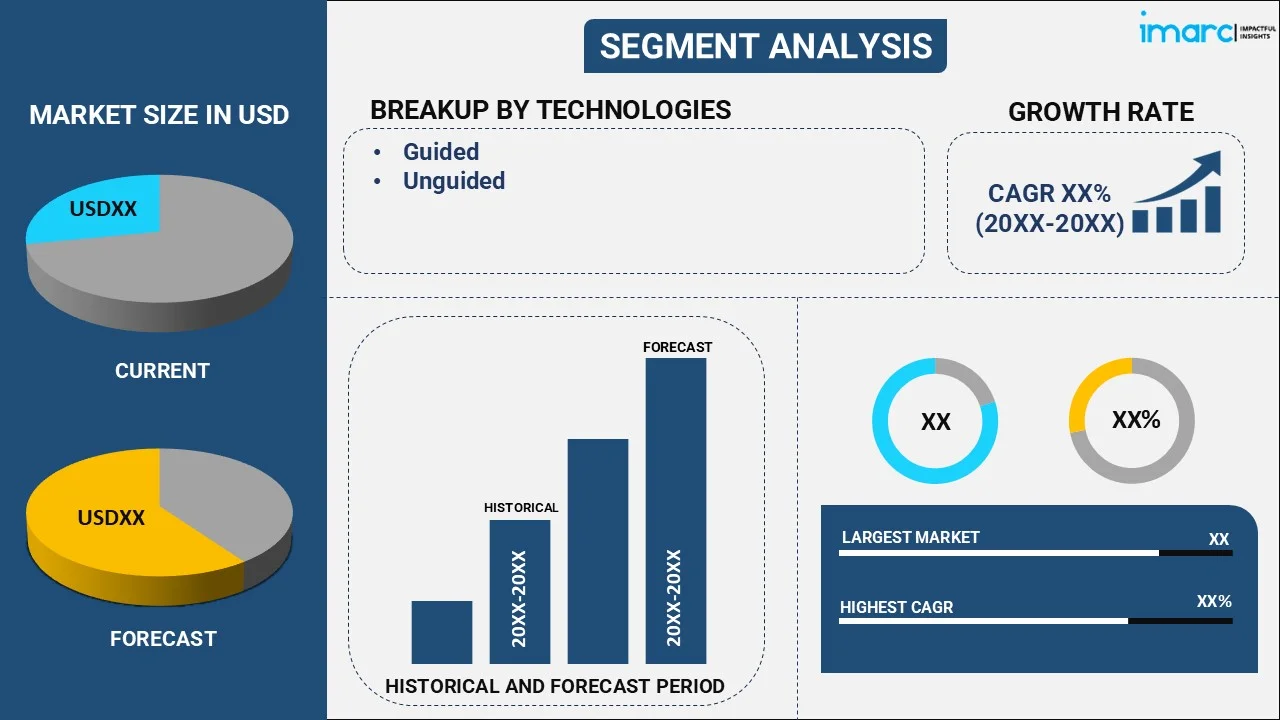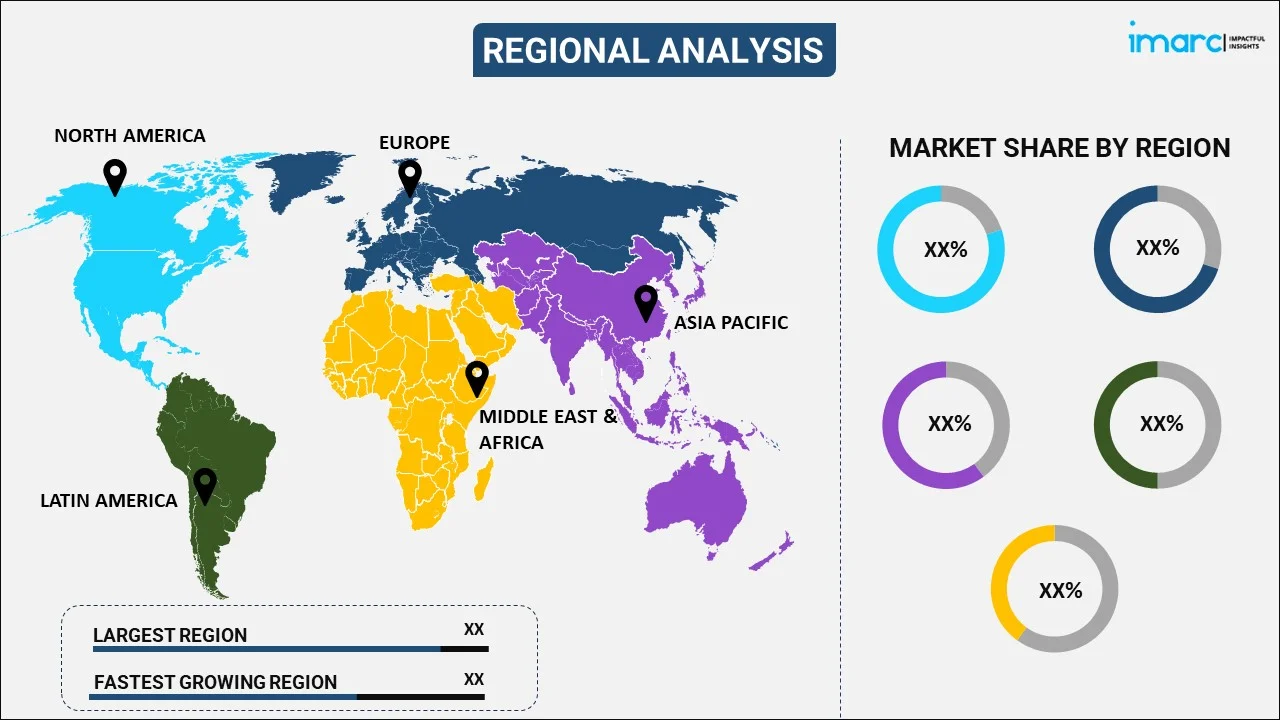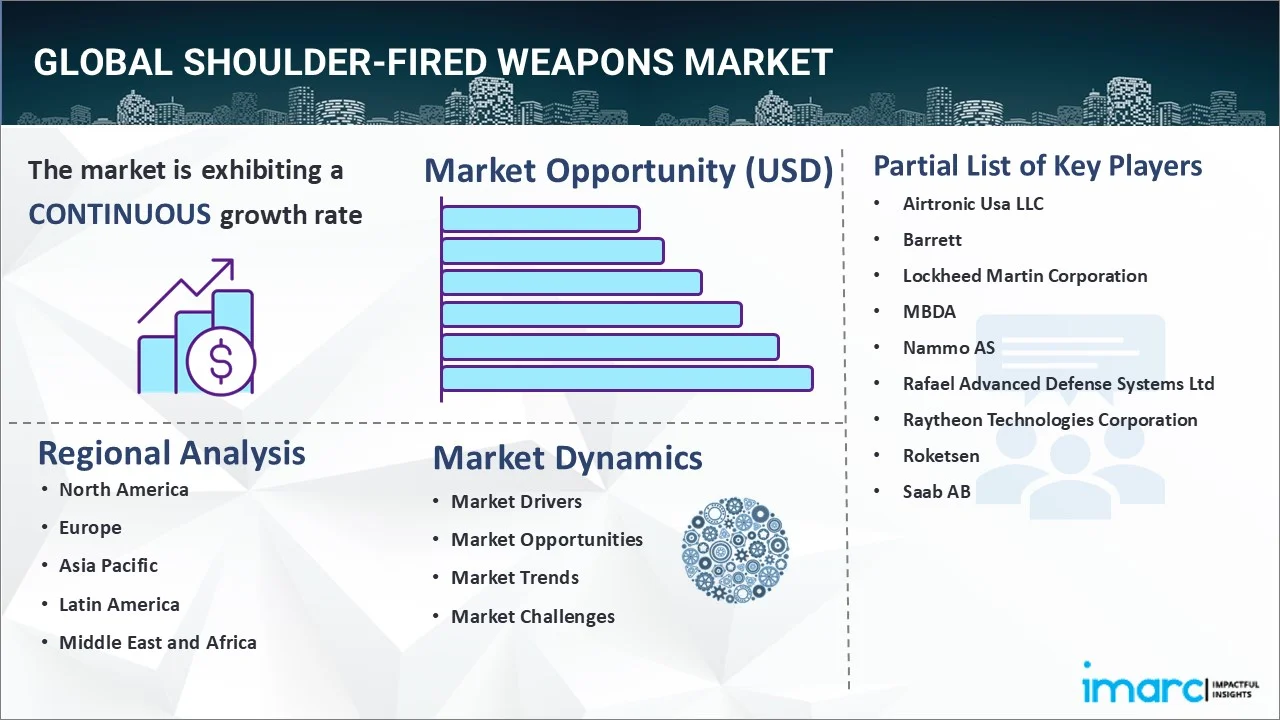
Shoulder-Fired Weapons Market Report by Technology (Guided, Unguided), Range (Short, Medium, Long), Assembly Type (Projectile, Launcher), Application (Defense, Home Security, and Others), and Region 2025-2033
Global Shoulder-Fired Weapons Market:
The global shoulder-fired weapons market size reached USD 7.1 Billion in 2024. Looking forward, IMARC Group expects the market to reach USD 11.2 Billion by 2033, exhibiting a growth rate (CAGR) of 4.87% during 2025-2033. The increasing military spending to enhance defense capabilities is stimulating the market.
|
Report Attribute
|
Key Statistics
|
|---|---|
|
Base Year
|
2024
|
|
Forecast Years
|
2025-2033
|
|
Historical Years
|
2019-2024
|
|
Market Size in 2024
|
USD 7.1 Billion |
|
Market Forecast in 2033
|
USD 11.2 Billion |
| Market Growth Rate 2025-2033 | 4.87% |
Shoulder-Fired Weapons Market Analysis:
- Major Market Drivers: The rising security concerns are driving the need for portable and effective combat systems like shoulder-fired weapons, which is propelling the market.
- Key Market Trends: The growing technological advancements are improving the accuracy and power of shoulder-fired weapons, further driving market growth.
- Competitive Landscape: Some of the major market companies include Airtronic Usa LLC, Barrett, Lockheed Martin Corporation, MBDA, Nammo AS, Rafael Advanced Defense Systems Ltd, Raytheon Technologies Corporation, Roketsen, and Saab AB, among many others.
- Geographical Trends: The high defense spending, advanced military technologies, and increased demand for portable, powerful weapon systems among armed forces are augmenting the market in North America.
- Challenges and Opportunities: The limited range restricts effectiveness in long-distance combat scenarios is hindering the market. However, advancements in propulsion and targeting systems will continue to catalyze the market over the forecasted period.
Shoulder-Fired Weapons Market Trends:
Increasing Demand for Advanced Anti-Tank Solutions
Modern military operations are placing a growing emphasis on more advanced anti-tank solutions to counter evolving threats. Moreover, the need for weapons that can effectively target and destroy armored vehicles in various terrains has driven the development of more accurate, versatile, and powerful shoulder-fired systems. For instance, in August 2024, DRDO successfully test-fired the indigenously developed Man-Portable Anti-Tank Guided Missile (MP-ATGM) in Jaisalmer, India. This shoulder-launched system, designed to destroy tanks and armored vehicles, strengthens India's defense capabilities. This is elevating the shoulder-fired weapons market revenue.
Expansion of Domestic Manufacturing Capabilities
Countries are increasingly focusing on enhancing their domestic manufacturing of shoulder-fired weapons to reduce dependence on imports and boost self-reliance. In addition, this trend is leading to innovations in production, improved defense capabilities, and the establishment of local supply chains for advanced military systems. For instance, in June 2024, the U.S. proposed co-producing Javelin shoulder-fired anti-tank missiles to meet the Army's needs. This joint production plan aims to boost India's defense capabilities and expand manufacturing, further driving the development of the shoulder-fired weapons market outlook.
Rising Focus on Lightweight and Portable Systems
The demand for portable and lightweight shoulder-fired weapons is growing as military forces seek to improve mobility and ease of use for soldiers. In contrast, these systems offer the advantage of quick deployment in various combat environments, making them highly valuable for modern defense strategies. For instance, in August 2024, Indonesia successfully tested the SLT, a locally developed shoulder-fired recoilless anti-tank weapon by Hariff Defense Technologies. This lightweight, reloadable system, with an effective range of up to 600 meters, strengthens Indonesia's defense capabilities and supports growth in the shoulder-fired weapons market.
Global Shoulder-Fired Weapons Industry Segmentation:
IMARC Group provides an analysis of the key trends in each segment of the market, along with the shoulder-fired weapons market forecast at the global, regional, and country levels for 2025-2033. Our report has categorized the market based on technology, range, assembly type, and application.
Breakup by Technology:

- Guided
- Unguided
Guided currently holds the largest shoulder-fired weapons market share
The report has provided a detailed breakup and analysis of the market based on the technology. This includes guided and unguided. According to the report, guided represented the largest market segmentation.
Guided shoulder-fired weapons use advanced targeting technology to improve accuracy, allowing users to lock onto moving targets and adjust trajectory mid-flight. This enhances effectiveness against armored vehicles and reduces collateral damage in combat.
Breakup by Range:
- Short
- Medium
- Long
Medium currently holds the largest shoulder-fired weapons market demand
The report has provided a detailed breakup and analysis of the market based on the range. This includes short, medium, and long. According to the report, medium represented the largest market segmentation.
Shoulder-fired weapons with medium range capabilities, typically around 300-600 meters, offer a balanced solution for infantry forces, allowing effective engagement of targets while maintaining mobility and flexibility in various combat scenarios.
Breakup by Assembly Type:
- Projectile
- Launcher
Projectile currently holds the largest shoulder-fired weapons market statistics
The report has provided a detailed breakup and analysis of the market based on the assembly type. This includes a projectile and launcher. According to the report, projectile represented the largest market segmentation.
The projectile serves as the key component designed to engage targets effectively. It can be tailored for tasks such as penetrating armored vehicles or disabling fortified structures with various warheads available, thereby enhancing combat effectiveness.
Breakup by Application:
- Defense
- Home Security
- Others
Defense currently holds the largest shoulder-fired weapons market value
The report has provided a detailed breakup and analysis of the market based on the application. This includes defense, home security, and others. According to the report, defense represented the largest market segmentation.
Shoulder-fired weapons play a crucial role in defense by offering portable, effective solutions for targeting armored vehicles, fortifications, and enemy personnel, thereby enhancing combat efficiency in diverse and challenging battlefield conditions.
Breakup by Region:

- North America
- United States
- Canada
- Asia-Pacific
- China
- Japan
- India
- South Korea
- Australia
- Indonesia
- Others
- Europe
- Germany
- France
- United Kingdom
- Italy
- Spain
- Russia
- Others
- Latin America
- Brazil
- Mexico
- Others
- Middle East and Africa
North America currently dominates the market
The shoulder-fired weapons market research report has also provided a comprehensive analysis of all the major regional markets, which include North America (the United States and Canada); Asia Pacific (China, Japan, India, South Korea, Australia, Indonesia, and others); Europe (Germany, France, the United Kingdom, Italy, Spain, Russia, and others); Latin America (Brazil, Mexico, and others); and the Middle East and Africa. According to the report, North America accounted for the largest market share.
As per the shoulder-fired weapons market overview, North America exhibits a clear dominance in the market due to its high defense spending, advanced military technologies, and continuous innovation in portable weapon systems. In addition, the region’s focus on modernizing military arsenals and increasing investments in research and development has strengthened its position, driving demand for cutting-edge shoulder-fired solutions and enhancing overall defense capabilities.
Competitive Landscape:
The market research report has provided a comprehensive analysis of the competitive landscape. Detailed profiles of all major market shoulder-fired weapons companies have also been provided. Some of the key players in the market include:
- Airtronic Usa LLC
- Barrett
- Lockheed Martin Corporation
- MBDA
- Nammo AS
- Rafael Advanced Defense Systems Ltd
- Raytheon Technologies Corporation
- Roketsen
- Saab AB
(Please note that this is only a partial list of the key players, and the complete list is provided in the report.)
Shoulder-Fired Weapons Market Recent Developments:
- September 2024: The U.S. Army granted a US$494 Million contract to Saab for the XM919 Individual Assault Munition, designed for multiple shoulder-fired systems. This new weapon enhances combat efficiency by reducing training requirements and soldiers' load, driving advancements in the shoulder-fired weapons market.
- August 2024: Indonesia successfully tested the SLT, a locally developed shoulder-fired recoilless anti-tank weapon by Hariff Defense Technologies.
- June 2024: The government authorities in the U.S. proposed co-producing Javelin shoulder-fired anti-tank missiles with India to meet the latter Army's needs. This joint production plan aims to boost India's defense capabilities and expand manufacturing, further driving the development of the shoulder-fired weapons market.
Shoulder-Fired Weapons Market Report Scope:
| Report Features | Details |
|---|---|
| Base Year of the Analysis | 2024 |
| Historical Period | 2019-2024 |
| Forecast Period | 2025-2033 |
| Units | Billion USD |
|
Scope of the Report |
Exploration of Historical Trends and Market Outlook, Industry Catalysts and Challenges, Segment-Wise Historical and Predictive Market Assessment:
|
| Technologies Covered | Guided, Unguided |
| Ranges Covered | Short, Medium, Long |
| Assembly Types Covered | Projectile, Launcher |
| Applications Covered | Defense, Home Security, Others |
| Regions Covered | Asia Pacific, Europe, North America, Latin America, Middle East and Africa |
| Countries Covered | United States, Canada, Germany, France, United Kingdom, Italy, Spain, Russia, China, Japan, India, South Korea, Australia, Indonesia, Brazil, Mexico |
| Companies Covered | Airtronic Usa LLC, Barrett, Lockheed Martin Corporation, MBDA, Nammo AS, Rafael Advanced Defense Systems Ltd, Raytheon Technologies Corporation, Roketsen, Saab AB, etc. |
| Customization Scope | 10% Free Customization |
| Post-Sale Analyst Support | 10-12 Weeks |
| Delivery Format | PDF and Excel through Email (We can also provide the editable version of the report in PPT/Word format on special request) |
Key Benefits for Stakeholders:
- IMARC's industry report offers a comprehensive quantitative analysis of various market segments, historical and current market trends, market forecasts, and dynamics of the shoulder-fired weapons market from 2019-2033.
- The research report provides the latest information on the market drivers, challenges, and opportunities in the global shoulder-fired weapons market.
- The study maps the leading, as well as the fastest-growing, regional markets. It further enables stakeholders to identify the key country-level markets within each region.
- Porter's five forces analysis assists stakeholders in assessing the impact of new entrants, competitive rivalry, supplier power, buyer power, and the threat of substitution. It helps stakeholders to analyze the level of competition within the shoulder-fired weapons industry and its attractiveness.
- The competitive landscape allows stakeholders to understand their competitive environment and provides insight into the current positions of key players in the market.
Key Questions Answered in This Report
The global shoulder-fired weapons market was valued at USD 7.1 Billion in 2024.
We expect the global shoulder-fired weapons market to exhibit a CAGR of 4.87% during 2025-2033.
The rising instances of armed conflicts, violence, and terrorism, along with the increasing integration of Artificial Intelligence (AI) and Machine Learning (ML) with shoulder-fired weapons that help military personnel deal with combatants on the battlefield and minimize the collateral damage, are primarily driving the global shoulder-fired weapons market.
The sudden outbreak of the COVID-19 pandemic has led to the implementation of stringent lockdown regulations across several nations, resulting in the temporary closure of numerous manufacturing units for shoulder-fired weapons.
Based on the technology, the global shoulder-fired weapons market has been segmented into guided and unguided. Currently, guided holds the majority of the total market share.
Based on the range, the global shoulder-fired weapons market can be bifurcated into short, medium, and long. Among these, medium exhibits a clear dominance in the market.
Based on the assembly type, the global shoulder-fired weapons market has been divided into projectile and launcher, where projectile currently accounts for the largest market share.
Based on the application, the global shoulder-fired weapons market can be segregated into defense, home security, and others. Currently, defense exhibits a clear dominance in the market.
On a regional level, the market has been classified into North America, Asia-Pacific, Europe, Latin America, and Middle East and Africa, where North America currently dominates the global market.
Some of the major players in the global shoulder-fired weapons market include Airtronic Usa LLC, Barrett, Lockheed Martin Corporation, MBDA, Nammo AS, Rafael Advanced Defense Systems Ltd, Raytheon Technologies Corporation, Roketsen, Saab AB, etc.
Need more help?
- Speak to our experienced analysts for insights on the current market scenarios.
- Include additional segments and countries to customize the report as per your requirement.
- Gain an unparalleled competitive advantage in your domain by understanding how to utilize the report and positively impacting your operations and revenue.
- For further assistance, please connect with our analysts.

 Request Customization
Request Customization
 Speak to an Analyst
Speak to an Analyst
 Request Brochure
Request Brochure
 Inquire Before Buying
Inquire Before Buying




.webp)




.webp)












